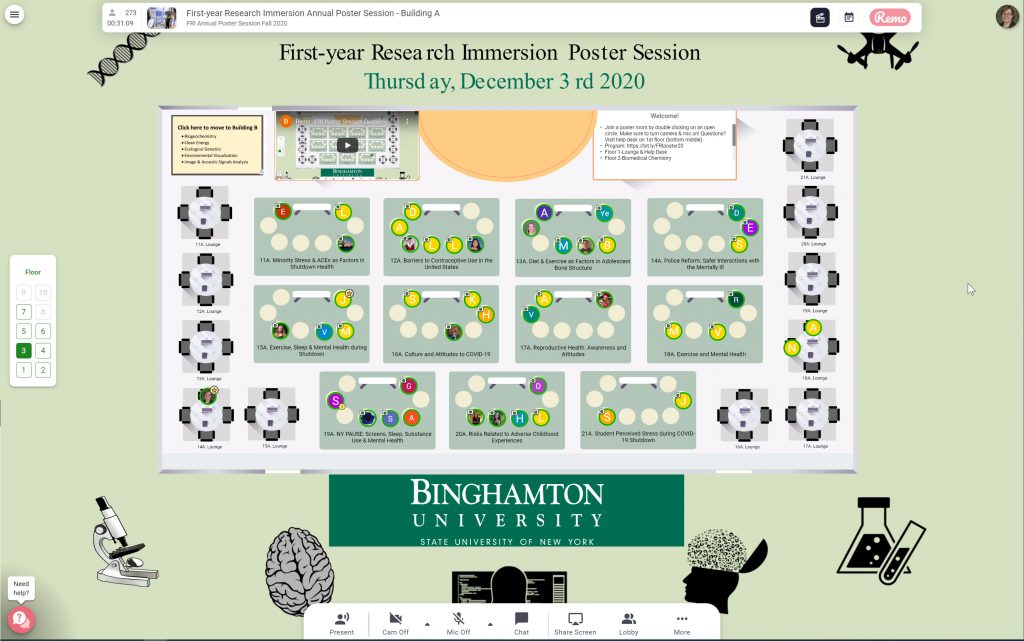Held virtually this year due to the COVID-19 pandemic, First-year Research Immersion (FRI) students, consisting of hundreds of freshmen and sophomores, presented at the annual FRI poster session.
The event took place on the virtual networking platform Remo on Dec. 3 from 3:30 p.m. to 5:30 p.m. Remo creates a mock event center, which FRI utilized to have a poster session take place in each different “room.” Remo differs from Zoom in that it uses a 2-D interactive map for all of the rooms in a venue. Attendees could choose between entering one of two different “buildings,” each consisting of six “floors,” with numerous poster sessions occurring on each floor. Each floor contained poster sessions from the same research stream, or area of research study.
Created in 2014, FRI has since grown from three research streams to 10. These research streams include biogeochemistry, biomedical chemistry, community and global public health, ecological genetics, environmental visualization, image and acoustic signals, microbial biofilms in human health, molecular and biomedical anthropology, neuroscience and clean energy. Research streams, which are directed by a research educator, consist of 30 undergraduate students each and have three to five stream collaborators, or faculty members.
The FRI program consists of first-year and second-year STEM majors, giving students the opportunity to learn research techniques and follow a real research topic to completion. This program is three semesters long, where students take part in a research seminar in the fall of their first year and a research stream in the spring of their first year until the fall of their second year.
Megan Fegley, director of the FRI program, said it was important for the FRI students to get as normal of an experience as possible when participating in the poster session.
“We felt it was really important to have a synchronous event where guests could talk with and virtually see the student presenters live and discuss their research while also being able to view their posters, figures and data,” Fegley wrote in an email. “We were able to set Remo up to look and feel like the in-person version of the poster session. Guests and students could easily move from poster to poster with the click of their mouse and talk with the presenters live in an environment that looked like a real poster session.”
Kyleigh Fitzgerald, an undeclared freshman, said she found it challenging to present at the poster session in an online format.
“It definitely seemed to be a little bit of a struggle to learn some new programs,” Fitzgerald said. “Personally I have not worked with [Microsoft Excel] very often and Microsoft Office, so trying to create the poster seemed a little difficult with trying to get everything to fit and have it be readable, which I think would have been a little bit different if it was an in-person poster because it’s obviously bigger.”
Due to technology issues, Lesly-Hannah Gutierrez, an undeclared freshman, found it stressful to present at the poster session.
“It was a real struggle to bring up the whiteboard, and we didn’t know if other students could see our board, and it took a while to actually begin,” Gurierrez said. “Also, I got kicked off of the site for a few minutes. This is probably because there’s [over] 319 students here, so it’s obviously an overflow. But, right now, we’re getting into the swing of things.”
Despite experiencing these technical difficulties, Gutierrez said the virtual poster event was successful.
“I think they’re trying their hardest,” Gutierrez said. “I feel like that’s the main theme, everyone’s trying their hardest, working toward making everything right, so I think we’re doing an okay job.”
In addition to the poster session being conducted remotely, Fegley said the experience of FRI students this year differed in numerous ways in comparison to years prior.
“Three of the research streams were taught fully online during the fall semester, and all of their projects had to be shifted to projects that could be completed remotely in March when the move to online instruction occurred,” Fegley wrote. “This meant teams in the community and global public health and molecular and biomedical anthropology research streams were analyzing large data sets that were publicly available or data that was gathered through surveys the students developed. Other teams were able to use remote computer systems and simulation software in the image and acoustic signals analysis research stream, [which is] computer science and engineering.”
Research streams dependent on in-person activities were able to continue, although with numerous restrictions, Fegley explained.
“For the seven research streams with in-person lab components, lab capacities had to be reduced and research projects were interrupted by the two-week pause of classes during the spike in [COVID-19] cases and the cyber attack,” Fegley wrote. “This meant students really had to rely on their teammates, delegate work and have an organized plan for both the students working in-person and online.”
Despite the shift to online learning, Fegley thinks that the FRI program was successful in teaching students.
“The [Harpur College-Wide 170: FRI Research Methods] course [for first-year students] was taught completely online this semester,” Fegley wrote. “Even in the online environment, we were able to incorporate active student learning, and the students adapted very well to the environment.”



